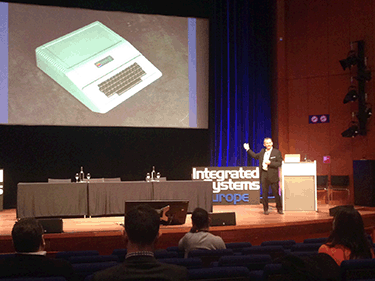- A vacuum in professional computing is the result of the evolution from desktop to laptop to mobile device. John Underkoffler, CEO, Oblong Industries, views the world through pixels as the key to filling that hole, which he shared in his Tuesday Smart Building Conference address: ‘The Future of Work – Workplace Collaboration Thrives in the Spatial Operating Environment.’
Underkoffler at ISE 2015.
As an advisor to the oft-exemplified futuristic film “Minority Report,” Underkoffler reluctantly shared a clip he musingly hoped was “the last time we have to look at this.” He asked the audience to watch it with new eyes. Instead of being wowed by the way ahead of its time gesture technology, something he derided as “not what’s important,” attendees were asked to look for what was missing.
“This sequence is as much about the collaboration and the room than it is the UI,” he said.
Applying that to today’s business technologies, Underkoffler asked, “How does computation extend [the] room? It doesn’t. [Modern computing devices] don’t care about the room. You have a bizarre complication.” Because they are so personal in nature, “They are anti-collaboration devices and anti-architectural devices.”
Underkoffler and Oblong Industries are working to get out of this “trap.” His solutions include the more pixels the better; pixel interoperability; a user interface capable of managing all the pixels all over the place; and plurality, the need for systems that think about more than one thing—enabling the physical and social space for more than one person to work in tandem.
By teaching a machine to speak pixels, multiple applications can run at the same time complementarily. Word documents and Excel spreadsheets can communicate with each other. “It’s a kind of a quantum leap between what you can do with a machine,” Underkoffler declared.
Part of this whole philosophy in the workplace of the future is that whatever you bring into a room makes you a participant. Then you can wrap the solution around VTC or telepresence. “The VTC part is just a piece of the whole experience. Alone, it is not enough. You need the work,” which resides in the data and pixels.
“We’re turning serialism into parallelism, linear into nonlinear, and raw technology into a more human approach.”

